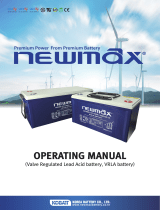
. . . . . . . . . . . . . . . . . . . . . . . . . . . . . . . . . . . . . . . . . .
CONTENTS
1 SAFETY ....................................................5
2 EQUIPMENT NEEDED ................................. 5
3 BATTERY INSTALLATION ........................... 6
3.1. Battery Connections ................................................ 6
3.2. Terminal Types ........................................................6
3.3. Correct Hardware Installation ..................................6
3.4. Cable Size ............................................................ 10
3.5. Torque Values ........................................................ 11
3.6. Terminal Protection ................................................12
3.7. Connecting Batteries in Banks ................................12
3.8. Ventilation ..............................................................13
3.9. Battery Orientation .................................................13
3.10. Battery Environment ...............................................13
3.11. Temperature ..........................................................13
4 PREVENTATIVE MAINTENANCE .............. 14
4.1. Inspection ............................................................. 14
4.2. Watering (flooded/wet batteries only) ..................... 14
4.3. Cleaning ............................................................... 16
5 CHARGING & EQUALIZING ........................16
5.1. Initial Charging ...................................................... 16
5.2. Normal Charging ................................................... 16
5.3. Equalizing (flooded/wet batteries only) .................. 20
6 STORAGE .................................................... 21
6.1. Storage in Hot Environments...................................21
6.2. Storage in Cold Environments .................................21
7 MAXIMIZING THE PERFORMANCE
OF YOUR TROJAN BATTERY ....................23
8 WHAT TO EXPECT FROM
YOUR TROJAN BATTERY..........................23
9 TROUBLE-SHOOTING .............................. 24
9.1. Preparation for Testing ..........................................24
9.2. Voltage Testing while Charging ..............................24
9.3. Specific Gravity (flooded/wet batteries only) ...........25
9.4. Open Circuit Voltage Testing .................................. 25
9.5. Discharge Testing .................................................26
10 BATTERY RECYCLING .............................. 27
11 BATTERY ABBREVIATIONS ...................... 28





















